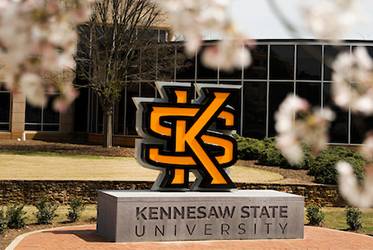
The Future of School Choice
KENNESAW, GA | Nov 17, 2017

The Program on Education Policy and Governance (PEPG), housed in the John F. Kennedy School of Government at Harvard University, hosted a conference on “The Future of School Choice: Helping Students Succeed.” The conference, organized by PEPG founder and director Dr. Paul Petersen, took place on September 28 and 29 of this year. Conference presenters included several education policy leaders and professors of economics, political science, and education from distinguished universities such as Harvard, Stanford, and Carnegie Mellon. However, only one individual made two presentations at the conference—Ben Scafidi, a professor of economics and director of the Education Economics Center in the Coles College of Business at Kennesaw State University.

Ben Scafidi presenting at the Kennedy School at Harvard University
Photo: Martha Stewart
First, Dr. Scafidi presented his research on the fiscal impact of the Indiana Choice Scholarship Program on public school districts. This scholarship program began in fall 2011, and by 2016-2017, over 34,000 Indiana students received state taxpayer-funded scholarships averaging over $4,000 each to attend the private school of their family’s choice. An important issue is the impact of such programs on students who remain in public schools. Using data from the first three years of the program, Dr. Scafidi and his co-author, Marty Lueken of EdChoice, found that losing students via scholarships appear to have had no real impact on pupil-staff ratios in public schools, where pupil-staff ratios equal the total number of full-time equivalent students divided by the number of full-time equivalent staff employed by the public schools. Staff includes teachers and all other public school employees.
Pupil-staff ratios in Indiana public schools declined by about 5 percent during the time period under study—which means that students in Indiana public schools had more access to staff relative to the year just before the creation of this scholarship program. That said, public school districts that lost more students via scholarships had essentially no discernible differences in the rate of improvement in staffing, when compared to public school students that lost smaller shares of students and when compared to districts that lost no students due to the scholarship program. Drs. Lueken and Scafidi used a large variety of empirical approaches and almost every approach found that public school districts who lost larger proportions of students via scholarships actually had slightly smaller pupil-teacher ratios, in the first three years after the creation of the program. None of these effects were large or statistically different from zero. Perhaps the fact that the Indiana public school districts got to retain virtually all of their taxpayer funding from federal and local sources contributed to the finding of no adverse impact on staffing in public schools.
The second paper that Dr. Scafidi co-presented was with Robert Enlow, also of EdChoice. Enlow and Scafidi’s “paper,” which is fast becoming a short book, is an update of Nobel Laureate Milton Friedman’s seminal work on education vouchers. In 1955, the economist Milton Friedman wrote a short chapter in an edited volume called “The Role of Government in Education”. In this short chapter, Dr. Friedman proposed separating the financing and provision of schooling by creating something that came to be known as a voucher system. Under a pure voucher system, the government would provide funding for students to attend the schools of their family’s choice, but government-owned schools would not receive any direct taxpayer funding. Under Friedman’s system both public and private schools would receive funding only from vouchers redeemed at the schools by parents who choose to send their children there and any additional fees the schools may charge. Pell grants, the Georgia HOPE Scholarship, Georgia’s Prekindergarten program, and the Indiana Choice Scholarship Program referenced above are, in some cases more and in some cases less, versions of Friedman’s voucher proposal.
At Harvard, Mr. Enlow and Dr. Scafidi presented their work on “The New Role of Government in Education,” an update and enhancement to Dr. Friedman’s original idea. Society has changed since 1955, there have been experiences with voucher programs for K—12 education in America and around the world, and there is now a significant amount of empirical research on voucher programs, so Enlow and Scafidi thought it was time to revisit Friedman’s idea. Enlow and Scafidi’s short book should be released in spring 2018, so stay tuned.
The attendees and presenters at the Harvard conference were a great mix of education policy leaders and academics who study education policy such as Paul Peterson, Patrick Wolf, Marty West, Mackie Raymond, Dennis Epple, Nina Rees, Michael Podgursky, Paul DiPerna, Betheny Gross, Doug Tuthill, Robert Pondiscio and many others. It was a great opportunity to share and discuss competing ideas and research. Dr. Scafidi especially enjoyed his conversations with Chris Cerf, former New Jersey State Commissioner of Education, regarding issues of transparency and accuracy in the reporting of public school data and the recent history of the Newark Public Schools.

Former New Jersey Commissioner of Education Chris Cerf and Ben Scafidi engage in a lively discussion on education policy. Photo: Martha Stewart
The keynote speaker at the conference was the US Secretary of Education, Betsy DeVos. Secretary DeVos spoke about her vision for federal education policy and had a spirited dialogue with Paul Peterson, Professor of Government at Harvard—and organizer of the conference, and with several Harvard students. After her remarks, Secretary DeVos spent time with conference participants, and took a few moments to ask Dr. Scafidi about the state of school choice in Georgia.

US Secretary of Education Betsy DeVos and Kennesaw State’s Ben Scafidi discuss Georgia’s school choice programs. Photo: Martha Stewart















